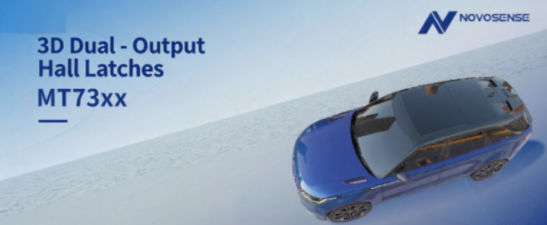MT73xx 3D Dual-Output Hall Latch Enables Precise Control of Automotive Motors by Simplifying Complex Magnetic Environments
2025-07-28 14:33:06 905
SHANGHAI, China -- NanoMicro's MT73xx series of dual output Hall latches based on the 3D Hall principle supports dual outputs of SS (Speed and Speed) or SD (Speed and Direction), and complies with the automotive Grade 0 standard, which can be widely used in the control systems of windows, tailgates, sunroofs and other motors to improve the accuracy and stability of speed and position detection, and optimize the comfort experience of the whole vehicle. and position detection accuracy and stability, optimizing the comfort experience of the whole vehicle.

Figure. 1
In motor control systems, accurate detection of speed and direction signals directly affects system response speed and operational stability. Traditional solutions usually rely on a combination of two Hall latches, which requires high precision in the installation of the magnetic ring and can easily lead to problems such as signal phase deviation, poor synchronization, and complex structure.
MT73xx series products integrate 3D Hall sensing structure with natural quadrature output characteristics, capable of simultaneously outputting two speed signals with 90° phase difference (SS output) or speed and direction signals (SD output), which is widely applicable to "speed-direction" detection scenarios. This design reduces the dependence on the installation accuracy of the magnetic ring pole position, effectively avoids the phase deviation of the dual signals, simplifies the system structure, improves the stability of the whole machine, and provides a more flexible and reliable solution for motion control detection.
VHS technology, adapting to multiple magnetic ring structures
In order to achieve high-precision 3D sensing effect, MT73xx series adopts NanoMicro's self-developed VHS (Vertical Hall Sensor) technology, which enables natural orthogonal outputs in any two axes through the combination of different axial sensing combinations of XY, YZ, and XZ, thus improving signal synchronization.
In addition, the MT73xx series is very compatible with the magnetic ring structure, whether axial, radial or shaped magnet structure, can maintain excellent duty cycle performance, so that users can flexibly adjust the design according to the characteristics of the magnetic ring and the installation environment, to further reduce the development difficulties and debugging costs.
Dual Outputs Optimize System Integration
In terms of system integration, the MT73xx's dual output feature can replace the traditional single or dual Hall solution by directly outputting SS (speed and velocity) or SD (speed and direction) signals to the ECU, reducing the need for peripheral redundant position sensors.
This design not only saves PCB space and simplifies structural design, but also enhances the integration of the solution, providing customers with greater freedom in innovative applications in the fields of motor control and smart cockpit.




